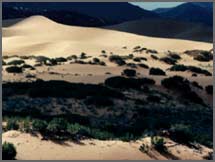Biosphere Contents
5. Development
Microhabitat is the immediate surface environment of an ecosystem

Whereas the term microclimate refers to a localised climate, microhabitat refers to a localised habitat or physical environment. Small changes in surface topography will have a noticeable influence on water conditions, for example, and thus the rooting environment. Local shelter provided by some feature of geological or geomorphological origin will allow a slightly different plant assemblage to occupy a site. This is most obvious in the case of sand dunes where the site conditions vary significantly with quantifiable plant responses. On a smaller scale the distribution of mosses on a forest floor will be affected by much more minor variations. In rivers the microhabitat of the reed bed area differs from that of the open channel; flowing waters differ from static waters. Sediment size distributions and flow rates differ across the pool and riffle sequences that most rivers exhibit at some points in their length. These differences in river microhabitat affect the development of the biofilm on the sediment surface, and the viability of the bacteria living within it. Deliberate habitat modification takes place in moorlands where the burning of small patches is practised to promote new heather growth. This may be carried out on a 5-15 year cycle so that larger stands of heather which provide shelter and cover for grouse will develop in an intimate patchwork with the younger food stands.
What does the term microhabitat refer to?